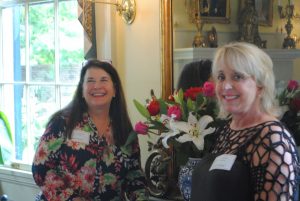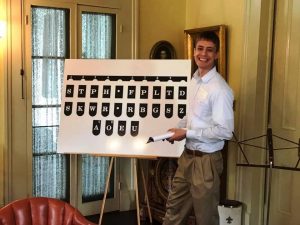in Mobile, Alabama – 2017
by Debra Amos Isbell, CCR,RDR,CRR,CRC,RSA
I have always enjoyed sharing my profession with interested witnesses and even a few times at career days when our children were in grade school, comparing the steno keyboard to the piano rather than the typewriter, playing “chords” for syllables. So when I was given the privilege to represent ACRA at the NCSA conference (National Committee of State Associations) at NCRA’s 2016 annual convention in Chicago, my interest was piqued by discussions of the A to Z Program created by NCRA Past President Nancy Varallo. There were several pioneer reporters implementing this program around the country with great success in introducing the profession to interested participants, pinpointing those exceptional students who want to continue their education at an accredited school and weeding out the ones that don’t have the patience and skill set to be successful in this demanding career.
Mind you, this was the very early stages of what was soon to be adopted as NCRA’s A to Z Program, which is now organized by Cynthia Andrews, Director of Professional Development Programs. At this time it was still considered Nancy Varallo’s personal project.
Our state association knew right away we wanted to be involved in this venture to encourage new people to enroll in court reporting school. I spent the next few months coordinating with Nancy, signing the Memorandum of Understanding, receiving the Pilot Project Theory Manual (later updated by NCRA), and attending several webinars where the initiators of the program shared their experiences.
In order to get started, we needed participants. By this time it was the spring of the year, and I began contacting some local public high school counselors. The timing was perfect, and two large high schools responded and invited me to their upcoming career days.
At this point I realized I could not take on this endeavor by myself, so I asked a couple of my colleagues if they would be co-leaders. Alan Peacock and Cindy Greene have always been cheerleaders for the profession. They accompanied me to the schools, and I loved seeing them share their enthusiasm with the students.
In all, we attended four high school career days from February to April. The Wisconsin Court Reporters Association provided us with their colorful, informative handout, which we amended for our area and, along with NCRA’s “Fresh Perspective” flyer, handed out to the students, explaining the upcoming A to Z Program. At this time no start date was announced, and we only heard from a few who said they may be interested in attending. I have to admit I was afraid we wouldn’t have enough participants to start the program. I wanted at least 10 since the pioneers seemed to think that was the ideal number. So I posted the brochure on Facebook, tagging Alan and Cindy so all of their friends would see it, too. It was shared many times. And by the end of April, we had seven interested participants, enough that I felt ready to announce a start date. Once again, unbeknownst to me, the timing was perfect as we decided to hold the classes in the summer on Saturday afternoons from June 3 to July 29, skipping the 4th of July weekend. We continued to solicit the program with the new start date, at one time having as many as 14 interested, and I became concerned we would have too many, but on start date there were 12 committed to the program.
Ah, now what? The location? No problem there. My office is located in an antebellum house in the historic Oakleigh Garden District in downtown Mobile. The conference room can easily hold 10; 15 with steno machines might be tight.
Machines! My husband and I graduated from the court reporting program at Gadsden State Community College a LONG time ago. We still had three paper writers. We dug them out of the closet, dusted them off and, of course, the ink and spools had all dried up. So we planned a trip to Top Cat Steno in Covington, Louisiana, to see if they could be repaired. In the meantime, I contacted reporters locally and statewide and even in New Orleans for loaner machines for the program. ACRA Board members stepped up to the plate. We received several more paper machines, supplies, and lots of Stenturas that wrote both on paper and digitally. We did make that trip to Covington and had four paper machines repaired and inked up only later to learn during the first class that the participants did not want the old-fashioned paper machines but the digital Stenturas. So ink and paper was superfluous.
One of the biggest pleasures in hosting this program was working with other reporters. Before the sessions began, I asked two reporters each week to participate as guest speakers. There was a nice representation of state and federal officials, freelancers and CART/captioners. One reporter, Patrick Miller, came down from Montgomery to represent the younger generation. ACRA’s president, Karen Strickland Planz, drove in from Dothan to head up a session. Guest speakers were chosen for the sessions prior to the commencement of the program and all lived up to the commitment. We decided to present four lessons from the theory book per week. The week before their scheduled session I emailed the guest speakers the lessons they were to cover, and the participants received the lessons for the week a day ahead of time with instructions to print and bring to class. The A to Z lesson manual is proprietary and only leaders who sign an MOU receive the entire book.
Each session was held on Saturdays from 1 to 4. A large (3×4) display of the steno keyboard was our main focus. Halfway through each session we would stop and have a snack. We tried to get through all of the lessons before our break and then spend the last part sharing our work experiences. (No war stories!) The three hours always went by quickly.
For the first session we had nine participants attend. Everyone wore nametags. Because of the time it takes to learn how to set up the machine, we just went over the introduction and first two lessons that day. There were three participants that couldn’t make it to the first class, so I met with them in the middle of the week for one hour to catch them up on what they had missed. The second session was the largest with 12 participants. As expected, we had several dropouts, three students who started late (in the middle of the program), and the last day eight who were given Certificates of Completion. Of those eight, two are enrolled in Gadsden State to start in August, four are interested in online programs, and two are returning to high school as seniors. Three participants had perfect attendance. Four of them traveled over an hour to class every week. I enjoyed getting to know them all. My hope is that when they get close to graduating, they will ask me to mentor them into the profession.
In addition to the well-planned lessons prepared by Nancy Varallo in the theory book, I wanted to educate the participants a bit on what the accredited schools had to offer. So before the sessions began, I contacted Gadsden State, the only accredited school in Alabama, and several online schools and learned about their programs. In addition, I set up a couple of webinars with online schools for the participants to attend midweek. Towards the end of the program I emailed them a short transcript of mine and asked them to proofread it and present whatever errors they found at the next class.
It was difficult for me to stay away from teaching certain letters as dictated by the theory manual. We had some good conversations between the reporters and participants on different writing styles which emphasized to them how unique and individual we all are. The students were very bright, and if we didn’t teach them something, they would ask.
The A to Z Program is a wonderful opportunity for students or career changers to become acquainted with the court reporting profession, and that is why I decided to launch the program in Mobile, Alabama. But the distinct pleasure that I did not foresee was the camaraderie we experienced working with fellow reporters. It was such fun seeing my colleagues sharing their teaching skills with the class! After wrapping up several of the sessions, we went out for dinner and enjoyed being together in the company of like-minded professionals.
Plans are currently in the works to begin an A to Z Program in the Birmingham area. I am proud of ACRA for being a team player with our national association and stepping up to encourage others to Take Note and Discover Steno.







 Map Us
Map Us